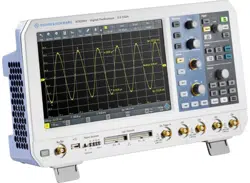Loading ...
Loading ...
Loading ...

Safety and regulatory information
R&S
®
RTB2000
9Getting Started 1333.1605.02 ─ 08
tweezers or pliers to avoid injuries. When transporting the accessories, always
use the box supplied with the probe.
●
Prevent the probe from receiving mechanical shock. Avoid putting excessive
strain on the probe cable or exposing it to sharp bends. Touching a broken
cable during measurements can cause injuries.
●
Set up all probe connections to the instrument before applying power.
Working with hazardous voltages
Voltages higher than 30 V RMS, or 42 V peak, or 60 V DC are regarded as haz-
ardous contact voltages. Direct contact with them can cause serious injuries.
Make sure that only electrically skilled persons use the products for measure-
ments on hazardous contact voltages. These working conditions require special
education and experience to perceive risks and to avoid hazards which electricity
can create.
When working with hazardous contact voltages, use protective measures to pre-
clude direct contact with the measurement setup:
●
Do not touch exposed connections and components when power is applied.
●
Switch off the test circuit while connecting and disconnecting probe leads.
●
Use only insulated voltage probes, test leads and adapters.
●
Make sure that the input leads fulfill the safety requirements for your measure-
ment.
The delivered input leads might have a jacket wear indicator that indicates a
worn jacket by different jacket color. In this case, do not use the input lead.
Replace it with a new one.
●
Do not use 4 mm banana plugs without protection against contact.
Working with current probes
When working with current probes, you can measure high-frequency currents or
currents that contain high-frequency components.
●
Switch off the test circuit while connecting the probe.
●
Do not attach the clamp to bare unisolated conductors. To avoid injury from a
short circuit, measure at a location on an insulated wire where the insulation is
sufficient for the circuit voltage.
●
Connect the probe only to the secondary side of a breaker. With this measure,
you avoid injury, if a short circuit occurs.
Safety instructions
Loading ...
Loading ...
Loading ...
